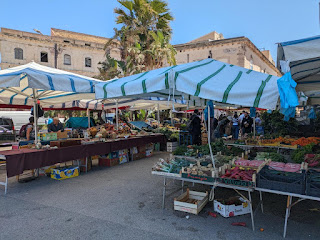I had planned an excursion of 2 days in Siracusa (Syracuse in English) because of its wealth of ancient Greek and Roman history, some 2700 years old. It was founded by the Greeks and was the home of famed mathematician and engineer Archimedes.
The picture is of the Fountain of Diana at Piazza Archimede so I'm getting ahead of myself, but otherwise I would have to start the post with a boring picture of Catania train station from which I took a train ride of just over an hour. Platforms of Italian train stations all look alike in their mundaneness.
The B&B I stayed in was the best of my Italian sojourn. The owners were extremely friendly and helpful. They worked in the film arts and the apartment was once the family home. They served fantastic breakfasts, but more later.
A 15 minute walk from the station and I was checking into my lodgings.
Most of the sights are on the island of Ortigia which was the original site of the Greek settlement. It's separated by a narrow channel from Siracusa on the "mainland".
Following the recommendation of my hosts I visited the market. It had many produce stalls.
A dairy stall.
Local produce.
I bought lunch of a panini from the deli/restaurant which was doing brisk business. Here's the prosciutto cotto (ham) in my sandwich. I took it to a shaded bench with a view of the sea. The temperature was near perfect at 24°C.
I found this stall selling candied fruit. I was interested in the cedro. Although this translates as cedar tree, and an infusion can be made from the leaves, it actually refers to a large fruit called citron in English. Citron is one of the ancestors of all citrus fruit. It's has more pith so isn't good for juicing, but the pith can be candied. The flavour is used to make a soft drink called cedrata, which I mistakenly thought was made from cedar.
And here's what a slice looks like. I like the shade of green. It was quite tasty and a change from other candied fruit.
Continuing my exploration I walked past the Temple of Apollo near the two bridges across the channel. Not much is left due to it having been repurposed in the past.



























No comments:
Post a Comment